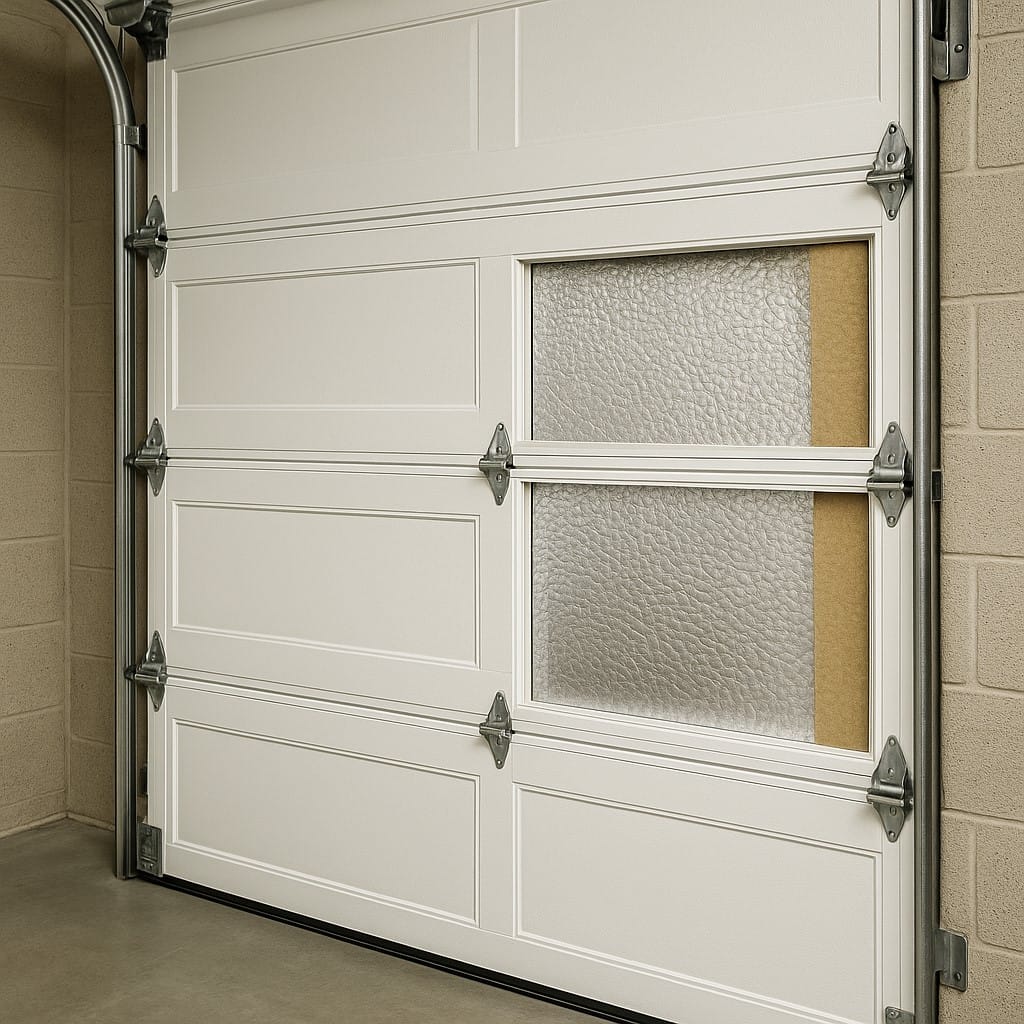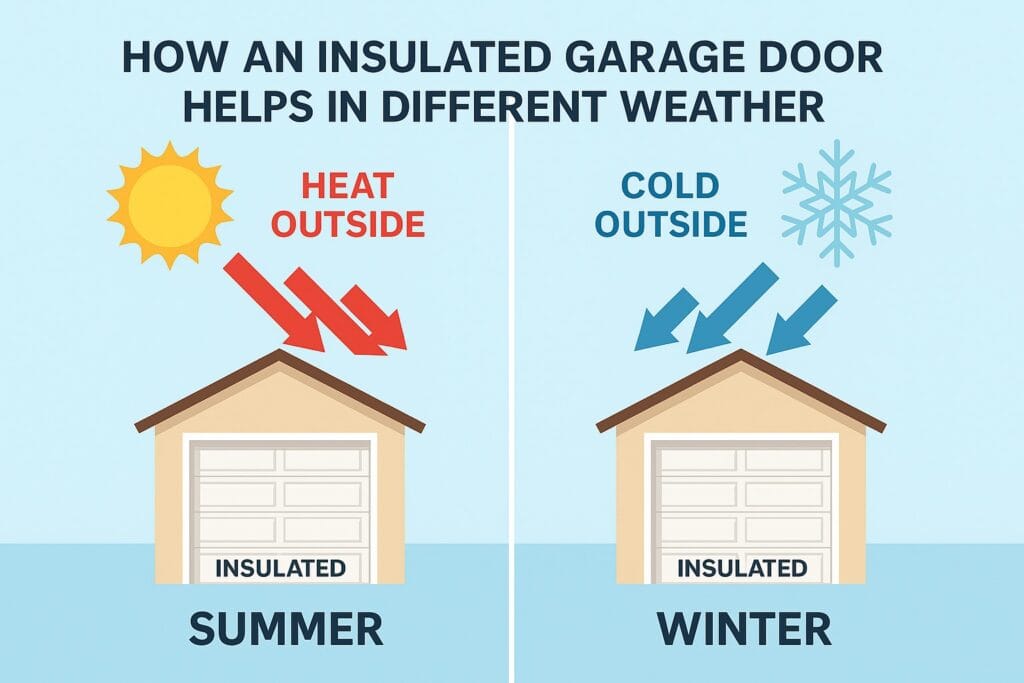How to Maintain Your Insulated Garage Door in Texas’s Extreme Weather

On one of the hottest days last summer, a homeowner in Richmond called us in a panic, their insulated garage doors were completely stuck. The cause? Heat expansion had distorted the aluminum panels and warped the foam insulation, causing the door to jam in its tracks. We’ve also seen fiberglass-insulated doors crack during Texas’s sudden winter freezes. From thermal transfer issues to logic board malfunctions in garage door openers, we’ve seen how Texas’s extreme temperatures can damage even the most durable doors.
Texas weather is as unpredictable as it is unforgiving. With summer temperatures soaring above 100°F and winter cold fronts plunging below freezing, the swing in temperature places unique stress on every part of your garage door system, especially if it’s not properly insulated. In fact, according to energy-efficiency reports, up to 30% of a home’s energy loss can occur through poorly insulated garage doors. That means your garage door plays a bigger role in your monthly energy bills than you might think.
At Covey Trails Garage Doors Co., located right here on Farm to Market 1093 in Richmond, TX, we specialize in helping homeowners and businesses protect their garage space from Texas’s harsh weather. Whether you have a steel sectional door with polyurethane foam or a craftsman-style garage door with batt insulation, we’ve created this detailed, easy-to-understand guide to help you maintain your insulated garage door and boost your long-term return on investment.
Why Insulated Garage Doors Matter in Texas
Insulated garage doors are more than just a modern upgrade, they’re a smart investment. In Texas, where extreme heat and cold are common, having proper insulation in your garage door helps regulate indoor temperature, improve energy efficiency, and extend the life of your door.

Key Benefits of Insulated Garage Doors:
- Energy Efficiency: Insulated doors reduce thermal transfer between outdoor and indoor spaces, helping maintain a steady temperature and lowering your HVAC system’s workload. High R-values (thermal resistance ratings) mean better insulation. Materials like urethane and polyurethane foam offer excellent R-values and heat insulation.
- Noise Reduction: Insulated doors are excellent at absorbing sound. Whether you’re using your garage as a workspace, gym, or simply want peace, insulation acts as a noise barrier.
- Durability: Insulated steel or aluminum garage doors are often constructed with multi-layer panels, which resist dents, weather damage, and wear better than non-insulated doors.
- Protection for Belongings: Many people store valuables, tools, and even HVAC systems in their garages. Insulated doors help protect these items from temperature swings and humidity.
- Improved Aesthetics & Value: Insulated garage doors from trusted brands like Clopay, Amarr, and Martin Garage Doors offer sleek designs and enhanced curb appeal.
If you’re still using a non-insulated garage door or relying on a thin door insulation kit, consider upgrading to an insulated option for long-term energy savings and improved comfort.
How Texas Weather Impacts Insulated Garage Doors
With its extreme climate, Texas poses unique challenges to both insulated and non-insulated garage doors. Thermal transfer due to intense sun exposure or frigid winds can compromise your door’s insulation materials and overall performance.

Common Weather-Related Issues:
- Heat Expansion: During summer, high temperatures can cause foam panels, metal tracks, and even the garage door opener’s logic board to expand or overheat. This leads to warping, track misalignment, or circuit board failures.
- Cold Contraction: In the winter, aluminum and steel materials contract. Combined with cold air infiltration through worn seals, this can cause insulation to crack or become less effective.
- Humidity Damage: Fluctuating humidity levels can affect wood or composite materials and may lead to mold or rot in poorly sealed, insulated garage doors.
If your garage door isn’t built with high-quality insulation materials, such as polyurethane, rigid foam, or polystyrene, it may struggle to cope with the changes in temperature and weather typical of Richmond and surrounding Texas areas.
Step-by-Step Guide to Maintaining Your Insulated Garage Door
1. Inspect the Weatherstripping
Start by examining the weatherstripping along the sides and bottom of the door. This acts as a first line of defense against dust, moisture, and hot or cold air. If the rubber is cracked, brittle, or peeling, replace it immediately. Quality garage door guides and insulation kits often include replacement seals.
2. Clean and Lubricate All Moving Parts
The hot Texas sun can cause grease to harden and dust to accumulate in your door’s mechanisms. Clean your rollers, hinges, and springs with a damp cloth, then apply a garage-specific silicone-based lubricant. Avoid general products like WD-40. This keeps sectional doors, opener arms, and light sockets operating smoothly.
3. Inspect Insulation Panels
Carefully inspect the insulation panels inside your garage door. Look for signs of damage such as separation, sagging, or mold. Panels made from polystyrene or polyurethane tend to hold up well, but even they can degrade over time, especially with exposure to UV rays and moisture.
4. Seal Cracks and Gaps
Even small air leaks can lead to massive energy loss. Check for gaps around the garage door frame, windows, or panels. Use weather-resistant caulk or insulation foam to plug any holes. If you’re using a DIY garage door insulation kit, make sure every section is sealed tightly.
5. Tighten Hardware
With the expansion and contraction of materials in Texas weather, bolts and screws may loosen. Inspect all fasteners on your garage door panels, brackets, opener mount, and tracks. Tightening these ensures the door operates smoothly and safely.
6. Test Door Balance
Unbalanced garage doors put strain on your opener and may lead to failure. Disconnect the opener, lift the door halfway, and see if it stays in place. If not, the springs may be worn or unbalanced, which can affect your entire system, including the garage door opener.
7. Check the Garage Door Opener
High summer temps can damage your opener’s logic board, cause chain expansion, or warp the casing. Ensure the opener operates at a consistent speed and that safety sensors are properly aligned. Chamberlain garage door and Craftsman garage door models often include diagnostic lights; use these for troubleshooting.
8. Schedule Professional Maintenance
A professional can assess deeper issues, perform safety checks, and help extend the life of your insulated garage door. At Covey Trails Garage Doors Co., we offer annual inspections that cover everything from foam insulation to opener electronics.
Seasonal Maintenance Tips for Texas Garages
Spring
- Clean the panels of pollen and debris
- Re-lubricate all hinges and rollers
- Inspect insulation for moisture damage
Summer
- Test door operation in high heat
- Check the opener for heat damage or slow response
- Inspect and replace warped seals or sun-faded parts
Fall
- Clear tracks of leaves and dust
- Tighten all hardware before cooler temperatures hit
- Recheck R-values for any insulation panels that feel soft
Winter
- Look for frost or ice buildup
- Test the insulation barrier’s ability to retain heat
- Replace any cracked insulation materials or brittle seals
Common Mistakes to Avoid
- Using the Wrong Insulation Material: Not all insulation kits are equal. Styrofoam and batt insulation may work in other climates, but often fall short in Texas. Choose high-density urethane or rigid foam products with strong R-values.
- Skipping Routine Maintenance: Garage doors are like cars; they need regular care to work properly.
- Ignoring Small Noises: Creaking or grinding sounds may be signs of spring tension issues or track misalignment, which could lead to costly repairs if not addressed early.
- DIY Electrical Work: Never attempt to fix or replace a logic board or motor unit yourself. Always call a certified technician.
Frequently Asked Questions (FAQs)
1. What is the best insulation material for a garage door in Texas?
Polyurethane foam is considered the best for Texas weather due to its high R-value, excellent thermal resistance, and ability to withstand extreme heat.
2. Can I install insulation on my existing non-insulated garage door?
Yes, you can use garage door insulation kits made of rigid foam or reflective materials to upgrade your current door, though it won’t perform as well as a factory-insulated door.
3. How often should I replace garage door insulation?
Garage door insulation typically lasts 10–15 years, but it may need earlier replacement if it becomes damaged by heat, moisture, or pests.
4. Will an insulated garage door help reduce my energy bills significantly?
Yes, especially if your garage is attached to your home, reducing heat transfer can lower heating and cooling costs throughout your house.
How Can Covey Trails Garage Doors Co. Help You?
At Covey Trails Garage Doors Co., we know that keeping your insulated garage door in peak condition is essential to protecting your garage space, improving energy efficiency, and reducing energy bills. Our team is based right here in Richmond, TX, and understands the unique challenges posed by the Texas climate.
📍 Our Location:
Farm to Market 1093, Richmond, TX 77406, United States
📞 Call Us Today: (713) 401-9063
We offer:
- Full maintenance for insulated garage doors and garage door openers
- Installation of high-quality insulated doors with superior R-values
- Reliable repairs using durable insulation materials, including polyurethane and steel options
- Expert advice on the best insulation type and garage door brands like Clopay, Amarr, and Martin Garage Doors
Don’t let the Texas weather take a toll on your garage. Let us help you protect your investment with professional care, smart upgrades, and prompt service.
👉 Contact us or visit us today to schedule your seasonal garage door checkup. Experience the Covey Trails difference where quality meets peace of mind.
